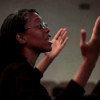Gospel Music for Non-Musicians: You Can Play "I'll Make It" by Hezekiah Walker

Even if you don't play the keyboard, you can play "I'll Make It"!
If there's no musician at your church, what are the options for the church choir? You can sing a cappella songs, of course, and you can use pre-recorded instrumental tracks for some songs. But along with those, there are some songs that are very, very simple to play, so simple that even a non-musician can learn them and play them.
This page is about a song like that -- "I'll Make It" by Hezekiah Walker and the Love Fellowship Crusade Choir. It's a lively song about faith that's great for both youth choirs and adult choirs.
I'll give you step-by-step instructions on how to play it. Follow along and soon your choir will be able to sing "I'll Make It" with live accompaniment.
Here's what the full song sounds like
They have a lot of instruments playing of course, but it will still sound great even if you have just a keyboard, as long as the choir sings with energy.
Use this keyboard as a guide

If you're not familiar with a piano keyboard, take a look at the picture above.
Notice that the black notes are grouped into groups of twos and threes. The names of the white notes keep repeating as they go up the keyboard. Look at the group of TWO black notes. The white note just to the left of this group is a C. Find another group of two black notes. Once again, the white note just to the left of it is a C. This is true all the way up and down the keyboard. The white note right in the middle of the group of two black notes is a D, and the note just to the right of the group of two is an E.
In the groups of THREE black notes, the white note just to the left of them is F, the white note after it is G, then the next one is A. The white note just to the right of the group of three is B, then you're back to another C heading toward another group of two.
Now, each black note can have two names. The black note that is between C and D can be called either C-sharp (C#) because it's a half-step higher than C, or D-flat (Db) because it's a half-step lower than D. The next black note can be called either D# or Eb, and so on.
In this instructional for "I'll Make It", I'm going to be calling the black notes flats.
Ready?
Here are the chords for "I'll Make It"
They just repeat over and over
There are 4 chords that you will play.
With each chord you play all of the notes at the same time. Use your right hand on the keyboard.
Count the time in your head as you play. Count to 4 at a moderate tempo and say "and" after each number in the count.
"1 - AND - 2 - AND - 3 - AND - 4 - AND ; 1 - AND - 2- AND - 3 - AND - 4 - AND . . ."
Here are the 4 chords:
- Chord 1: Db-Eb-Gb-Bb. Put your thumb on the Db, your index finger on the Eb, your middle finger on the Gb, and your pinky on the Bb. Play it on each pulse as you count, so you'll hit it 8 times during your four-count.
- Chord 2: C-Eb-Gb-Bb. Move your thumb down to the C, and keep your other fingers where they were. Play it the same way as the first chord, 8 pulses during your four-count.
- Chord 3: Db-F-Ab. Move your thumb up to the Db, your index finger up to the F, and your middle finger up to the Ab (you won't use your fourth finger in this chord). Play it 8 times during your four-count.
- Chord 4: Db-E-Ab-Bb. Keep your thumb the same, move your index finger down to the E, keep your middle finger the same, and add your fourth finger on the Bb. Play it 8 times during your four-count.
- Then you go back to Chord 1 and keep repeating the sequence of four chords. When you reach the very end of the song, you'll hit Chord 4 only three times instead of the usual eight times.
Practice until you can hit all of the chords without losing the beat.
These are the only chords needed for "I'll Make It". The musicians on the recording add some other riffs and breakdowns, but this basic progression will be enough to accompany a choir.
Now start the YouTube video again and see if you can play along with it.
If you want to buy a copy of the original recording, here it is: - This is the 2002 version with John P. Kee as a guest vocalist









